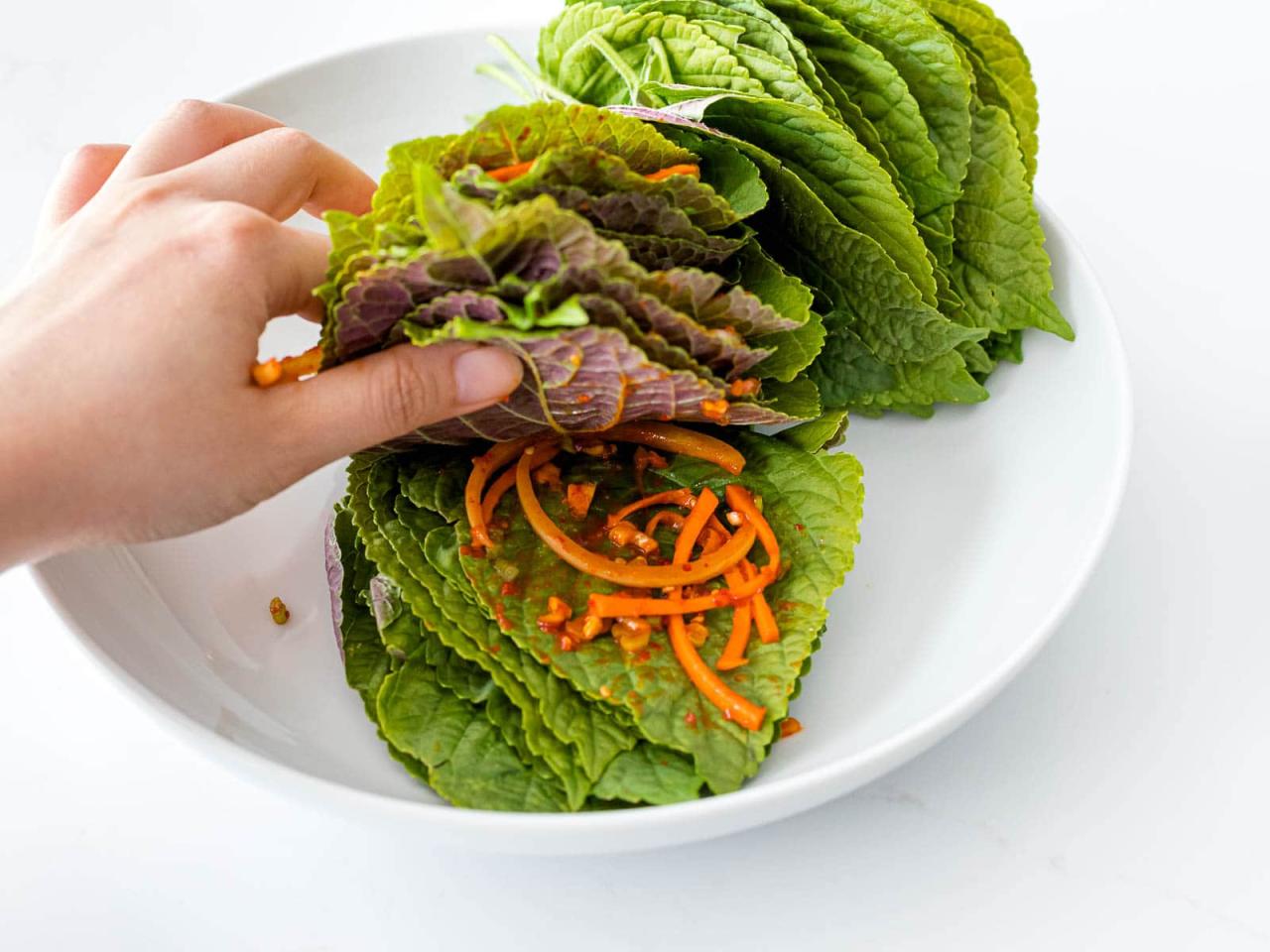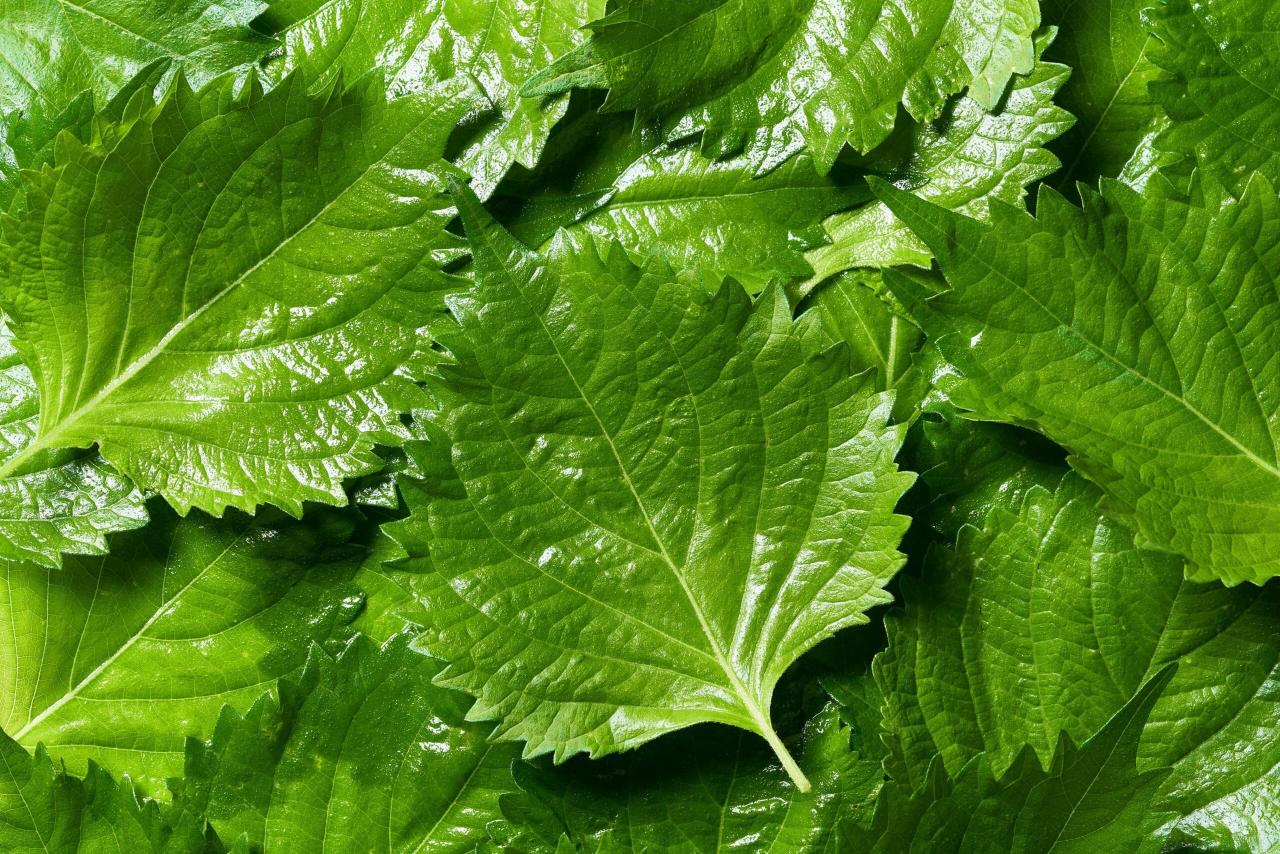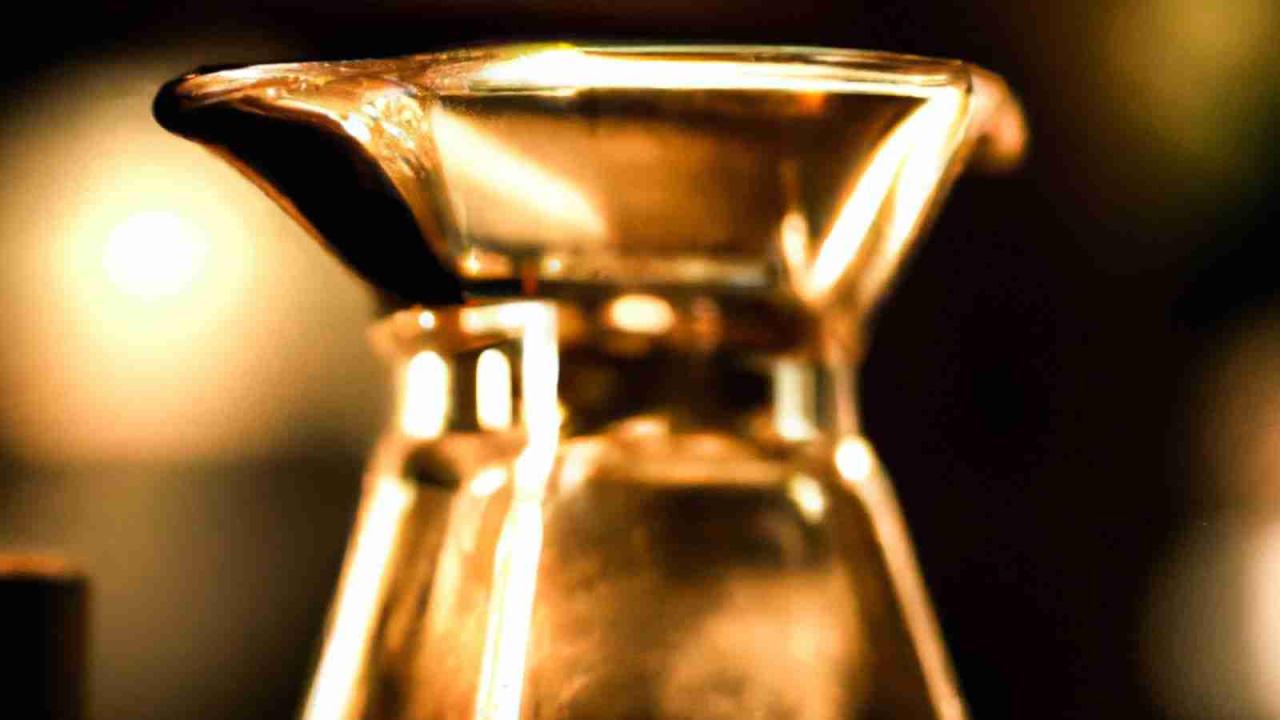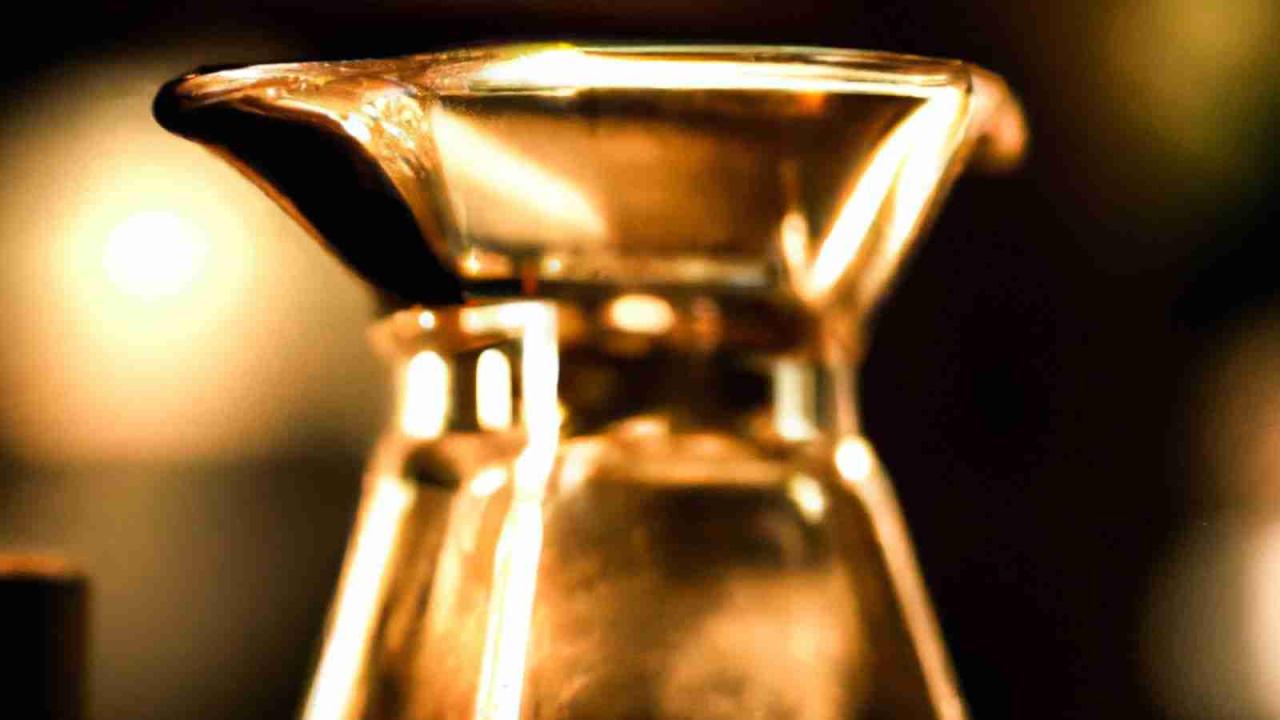How to Cook with Perilla Leaf: Essential Tips for Creating Fresh and Flavorful Dishes – Perilla leaf, a vibrant green herb with a unique flavor profile, has captivated culinary enthusiasts for centuries. From its traditional use in Asian cuisines to its recent rise in global popularity, this versatile ingredient offers a world of culinary possibilities.
This guide explores the diverse applications of perilla leaf, providing essential tips and techniques to unlock its full potential and create dishes that are both fresh and flavorful.
Beyond its culinary appeal, perilla leaf boasts impressive nutritional benefits. Rich in antioxidants and essential vitamins, incorporating this herb into your diet can enhance your overall well-being. Whether you’re a seasoned chef or a home cook looking to expand your culinary repertoire, this comprehensive guide will empower you to confidently embrace the culinary magic of perilla leaf.
Introduction to Perilla Leaf

Perilla leaf, also known as shiso, is a versatile herb with a unique and complex flavor profile that adds a burst of freshness and intrigue to dishes. Its vibrant green leaves, often used in Asian cuisine, offer a combination of minty, citrusy, and slightly spicy notes, making it a culinary treasure for adventurous cooks.
Flavor Profile of Perilla Leaf
Perilla leaf’s flavor is often described as a blend of mint, basil, and citrus, with a subtle hint of spice. The exact flavor can vary depending on the variety and how it’s prepared. For example, the leaves can have a more pronounced minty flavor when used fresh, while a dried perilla leaf has a more intense, almost peppery note.
This multifaceted flavor profile allows perilla leaf to complement a wide range of ingredients and dishes.
Versatility of Perilla Leaf in Cuisines
Perilla leaf is a culinary staple in many Asian cuisines, particularly in Japan, Korea, and China. It’s commonly used in various dishes, including:
- Japanese Cuisine:Perilla leaf is often used as a garnish for sushi and sashimi, adding a refreshing touch to the delicate flavors of raw fish. It’s also incorporated into salads, tempura, and ramen dishes.
- Korean Cuisine:In Korean cuisine, perilla leaf is used in various dishes, including bibimbap, a mixed rice bowl, and kimchi, a fermented cabbage dish. Its distinctive flavor adds depth and complexity to these flavorful dishes.
- Chinese Cuisine:Perilla leaf is used in Chinese cooking, often as a garnish for stir-fries and noodle dishes. It adds a vibrant green color and a refreshing minty note to these dishes.
Beyond Asian cuisine, perilla leaf is finding its way into other culinary traditions, as chefs and home cooks alike are discovering its unique flavor and versatility. It can be used to elevate the flavors of salads, soups, sauces, and even desserts.
Nutritional Benefits of Perilla Leaf
Perilla leaf is not only delicious but also packed with nutrients. It’s a good source of vitamins A and C, as well as antioxidants. Studies have shown that perilla leaf may have various health benefits, including:
- Anti-inflammatory properties:Perilla leaf contains compounds that may help reduce inflammation in the body.
- Improved brain function:Perilla leaf may help improve cognitive function and memory.
- Heart health benefits:Perilla leaf may help lower blood pressure and cholesterol levels.
Incorporating perilla leaf into your diet can provide a delicious and nutritious way to enhance your meals while potentially enjoying some health benefits.
Choosing and Preparing Perilla Leaf
The key to unlocking the full potential of perilla leaf lies in selecting and preparing it correctly. This ensures that you have fresh, vibrant leaves that will deliver the most flavorful and aromatic experience in your dishes.
Selecting Fresh Perilla Leaves
When choosing perilla leaves, prioritize freshness and vibrant color. Look for leaves that are bright green, with no signs of wilting, yellowing, or browning. The leaves should be firm and have a pleasant, slightly peppery aroma.
Varieties of Perilla Leaf
Perilla leaf comes in various varieties, each offering a unique flavor profile. Understanding these differences allows you to choose the perfect variety for your culinary creations.
- Green Perilla (Shiso):The most common variety, green perilla offers a fresh, slightly peppery flavor with hints of mint. It’s versatile and can be used in various dishes, from salads to stir-fries.
- Red Perilla (Aka-Shiso):This variety boasts a deeper, more intense flavor with a hint of sweetness. It’s often used as a garnish or to add a vibrant color contrast to dishes.
- Purple Perilla (Murasaki-Shiso):Known for its striking purple hue, purple perilla offers a slightly sweet, slightly spicy flavor. It’s commonly used in Japanese cuisine, particularly in pickled dishes.
Cleaning Perilla Leaves
Before using perilla leaves, it’s crucial to clean them thoroughly to remove any dirt or debris. Here’s a simple method:
- Rinse Under Cold Water:Gently rinse the leaves under cold running water, making sure to remove any dirt or residue.
- Soak in Cold Water:Soak the leaves in a bowl of cold water for about 5 minutes. This helps remove any lingering dirt or insects.
- Pat Dry:Gently pat the leaves dry with a clean kitchen towel or paper towels.
Storing Perilla Leaves
To preserve the freshness and flavor of perilla leaves, proper storage is essential. Follow these guidelines:
- Refrigerator Storage:Wrap the leaves loosely in a paper towel or clean kitchen towel and store them in a plastic bag or airtight container in the refrigerator. They can last for up to a week.
- Freezing:For longer storage, freeze the leaves. Blanch them for a few seconds in boiling water, then shock them in ice water. Drain and pat dry, then store in freezer-safe bags or containers. Frozen perilla leaves can last for up to 6 months.
Perilla leaf, with its vibrant green hue and unique flavor, is a versatile ingredient that can elevate any dish. Whether you’re adding it to stir-fries, marinades, or even crafting a vibrant pesto, its aromatic qualities are sure to impress.
For a visual feast to accompany your culinary creations, consider incorporating the beauty of nature’s autumnal palette. A stunning autumn leaf garland, as detailed in How to Design a Stunning Autumn Leaf Garland: Tips for a Cozy Fall Atmosphere , will bring warmth and charm to your dining space, creating a perfect ambiance for enjoying your perilla-infused dishes.
Cooking with Perilla Leaf
Perilla leaf, with its unique aroma and flavor, can be incorporated into a variety of dishes, adding a distinct touch to your culinary creations. From simple salads to complex sauces, perilla leaf’s versatility allows it to shine in various cooking methods.
Cooking Methods for Perilla Leaf
The versatility of perilla leaf extends to its diverse cooking methods. It can be used fresh, cooked, or even infused into sauces, allowing for a range of flavor profiles.
Cooking Method |
Description |
Flavor Profile |
|---|---|---|
Sautéing |
Sautéing perilla leaf in a small amount of oil brings out its aroma and creates a slightly wilted texture. |
The leaves retain their vibrant green color and offer a fresh, slightly peppery flavor. |
Grilling |
Grilling perilla leaf adds a smoky depth to its flavor, creating a more robust taste. |
The leaves develop a charred aroma and a slightly bitter note, complementing grilled meats and vegetables. |
Stir-frying |
Stir-frying perilla leaf quickly in a hot wok enhances its fragrance and creates a crispy texture. |
The leaves retain their vibrant green color and offer a fresh, slightly peppery flavor, adding a delightful crunch to stir-fries. |
Deep-frying |
Deep-frying perilla leaf results in a crispy and flavorful snack. |
The leaves become incredibly crunchy and develop a more pronounced flavor, making them a perfect accompaniment to various dishes. |
Adding to Salads |
Adding perilla leaf to salads provides a fresh, aromatic, and slightly spicy element. |
The leaves add a vibrant green color and a refreshing, slightly peppery flavor to salads, complementing various ingredients. |
Infusing into Sauces |
Infusing perilla leaf into sauces adds a unique aroma and depth of flavor. |
The leaves impart a subtle peppery note and a refreshing aroma to sauces, enhancing their complexity and creating a distinctive flavor profile. |
Flavor Pairings for Perilla Leaf
Perilla leaf’s unique flavor profile pairs well with a range of ingredients, creating harmonious and delicious combinations.
- Seafood:Perilla leaf complements the delicate flavors of fish and shellfish, particularly when grilled or pan-seared. Its slightly peppery note adds a refreshing contrast to the richness of seafood.
- Meat:The slightly bitter and peppery notes of perilla leaf balance the richness of meats like pork, chicken, and duck. It’s particularly well-suited for grilled or roasted meats.
- Vegetables:Perilla leaf pairs well with a variety of vegetables, including cucumbers, tomatoes, onions, and peppers. Its fresh and slightly spicy flavor adds a unique dimension to salads and stir-fries.
- Soy-based dishes:Perilla leaf’s slightly peppery flavor complements the savory notes of soy sauce and other soy-based ingredients. It’s often used in Korean dishes like bibimbap and japchae.
- Rice:Perilla leaf can be added to rice dishes to impart a unique aroma and flavor. It’s commonly used in Korean rice bowls and sushi.
Simple Perilla Leaf Salad with Vinaigrette Dressing
This simple salad showcases the refreshing flavor of perilla leaf and is perfect for a light lunch or side dish.
Ingredients:
- 1 cup perilla leaves, washed and dried
- 1/2 cup cherry tomatoes, halved
- 1/4 cup thinly sliced red onion
- 1 tablespoon olive oil
- 1 tablespoon rice vinegar
- 1 teaspoon soy sauce
- 1/2 teaspoon sesame oil
- Pinch of salt and pepper
Instructions:
- In a large bowl, combine the perilla leaves, cherry tomatoes, and red onion.
- In a small bowl, whisk together the olive oil, rice vinegar, soy sauce, sesame oil, salt, and pepper.
- Pour the dressing over the salad and toss to coat.
- Serve immediately.
Perilla Leaf in Asian Cuisine
Perilla leaf, with its unique aroma and flavor, has been a staple ingredient in Asian cuisines for centuries. Its versatility allows it to be used in various dishes, from savory stir-fries to refreshing salads and even sweet desserts.
Perilla Leaf in Korean Cuisine
Perilla leaf, known as “kkeut” in Korean, is a beloved ingredient in Korean cuisine, celebrated for its distinct, slightly spicy, and nutty flavor.
- Korean BBQ:Perilla leaf is commonly used as a wrap for grilled meats like bulgogi and samgyeopsal, adding a burst of flavor and freshness. It is often served alongside a dipping sauce, such as ssamjang (a fermented soybean paste sauce).
- Kimchi:Perilla leaf is often used in various kimchi recipes, contributing its unique flavor profile to the fermented dish.
- Perilla Leaf Pancake (Perilla Jeon):Perilla jeon is a popular Korean street food made by battering and pan-frying perilla leaves. The resulting pancake is crispy on the outside and soft on the inside, offering a delightful combination of textures and flavors.
Perilla Leaf in Japanese Cuisine, How to Cook with Perilla Leaf: Essential Tips for Creating Fresh and Flavorful Dishes
In Japanese cuisine, perilla leaf, known as “shiso,” is a versatile ingredient with a slightly minty and citrusy flavor.
- Sushi and Sashimi:Shiso leaves are often used as a garnish for sushi and sashimi, adding a refreshing element and complementing the taste of the raw fish.
- Tempura:Shiso leaves are sometimes battered and deep-fried as tempura, offering a crispy and flavorful side dish.
- Shiso Pickles:Shiso leaves are pickled in vinegar and sugar, creating a tangy and aromatic condiment often served with grilled fish or rice.
Perilla Leaf in Chinese Cuisine
Perilla leaf, known as “zi su” in Chinese, is used in Chinese cuisine, primarily in the southern regions.
- Stir-fries:Perilla leaves are often added to stir-fries, contributing their unique flavor and aroma to the dish.
- Soups:Perilla leaves are sometimes added to soups for their distinct flavor and nutritional value.
- Dipping Sauce:Perilla leaves are used in some dipping sauces, adding a refreshing and slightly spicy element to the sauce.
Perilla Leaf Pancake (Perilla Jeon) Recipe
Ingredients:
- 1 cup perilla leaves, washed and drained
- 1/2 cup all-purpose flour
- 1/4 cup cornstarch
- 1 egg
- 1/2 cup water
- 1/2 teaspoon salt
- Vegetable oil, for frying
Instructions:
- In a large bowl, whisk together the flour, cornstarch, egg, water, and salt until smooth.
- Dip each perilla leaf into the batter, ensuring it is fully coated.
- Heat a generous amount of vegetable oil in a large skillet over medium heat.
- Carefully place the battered perilla leaves in the hot oil, ensuring not to overcrowd the skillet.
- Fry for about 2-3 minutes per side, or until golden brown and crispy.
- Remove the perilla jeon from the skillet and drain on paper towels.
- Serve immediately while hot, with a dipping sauce of your choice.
Creative Applications of Perilla Leaf: How To Cook With Perilla Leaf: Essential Tips For Creating Fresh And Flavorful Dishes

Perilla leaf’s versatility extends beyond traditional Asian cuisine, offering a spectrum of creative applications to elevate the flavors of your dishes. From infusing oils and vinegars to crafting vibrant pestos, perilla leaf adds a unique, aromatic dimension to culinary creations.
Infusing Oils and Vinegars
Perilla leaf’s distinct aroma and flavor profile lend themselves beautifully to infusing oils and vinegars. This process extracts the essence of the leaf, creating a flavorful condiment that can be used in various applications.
Instructions
- Wash and dry perilla leaves thoroughly.
- Choose your oil or vinegar. Popular options include olive oil, sesame oil, rice vinegar, or apple cider vinegar.
- Place the perilla leaves in a clean glass jar or bottle. Pour the oil or vinegar over the leaves, ensuring they are completely submerged.
- Seal the jar tightly and store it in a cool, dark place for at least 2 weeks, allowing the flavors to infuse.
- After the infusion period, strain the oil or vinegar through a fine-mesh sieve or cheesecloth to remove the leaves.
- Store the infused oil or vinegar in a clean, airtight container in a cool, dark place.
Uses
- Perilla-infused oil can be used as a finishing oil for salads, pasta dishes, or roasted vegetables.
- Perilla-infused vinegar can be used as a dressing for salads, as a marinade for grilled meats or fish, or as a flavor enhancer in stir-fries.
Perilla Leaf Pesto
Perilla leaf pesto is a vibrant and flavorful condiment that adds a unique twist to traditional pesto. It can be enjoyed as a spread for sandwiches, a topping for pasta, or a sauce for grilled meats or fish.
Perilla leaf, with its vibrant green hue and unique flavor, can add a refreshing twist to any dish. Whether you’re using it in salads, stir-fries, or even as a garnish, the key to unlocking its full potential lies in understanding its subtle nuances.
Just as a gardener can cultivate a lush patch of ivy from simple cuttings, The Quick & Simple Guide to Propagating Ivy from Cuttings , you can master the art of cooking with perilla leaf by following a few essential tips.
From choosing the right leaves to incorporating them into your culinary creations, there’s a world of flavor waiting to be explored with this versatile ingredient.
Ingredients
- 1 cup packed perilla leaves
- 1/2 cup pine nuts or walnuts
- 1/4 cup grated Parmesan cheese
- 2 cloves garlic
- 1/4 cup olive oil
- Salt and freshly ground black pepper to taste
Instructions
- Combine all ingredients in a food processor and pulse until a smooth paste forms.
- Adjust the consistency by adding more olive oil if needed.
- Season with salt and pepper to taste.
Garnishing Dishes with Perilla Leaf
Perilla leaf’s vibrant green color and delicate aroma make it an excellent garnish for various dishes. Its versatility allows it to be incorporated into both savory and sweet presentations.
Visual Guide
- Savory Dishes:Perilla leaves can be used to garnish sushi rolls, noodle dishes, stir-fries, grilled meats, and fish.
- Sweet Dishes:Perilla leaves can be used to garnish desserts like ice cream, fruit salads, and cakes.
- Presentation:Perilla leaves can be arranged in various ways, such as:
- Whole leaves: Place whole leaves on top of dishes for a simple and elegant garnish.
- Torn leaves: Tear leaves into smaller pieces and scatter them over dishes for a more rustic look.
- Chiffonade: Cut leaves into thin strips for a delicate and elegant garnish.
- Stacked leaves: Stack leaves vertically for a visually appealing presentation.
Outcome Summary

From simple salads to elaborate Asian dishes, perilla leaf’s versatility knows no bounds. Whether you’re infusing its unique flavor into oils and vinegars or crafting a vibrant pesto, the possibilities are endless. By exploring the diverse techniques and recipes presented in this guide, you can unlock the full potential of this remarkable herb and elevate your culinary creations to new heights.
FAQ Guide
Is perilla leaf the same as shiso?
Yes, perilla leaf is also known as shiso. While there are different varieties, the term “perilla leaf” is often used interchangeably with “shiso” in culinary contexts.
Where can I find perilla leaf?
Perilla leaf can be found at Asian grocery stores, specialty markets, and some larger supermarkets. It is also increasingly available online.
Can I substitute perilla leaf with another herb?
While perilla leaf’s unique flavor is hard to replicate, you can experiment with similar herbs like basil, mint, or cilantro depending on the dish. However, the flavor will be different.
